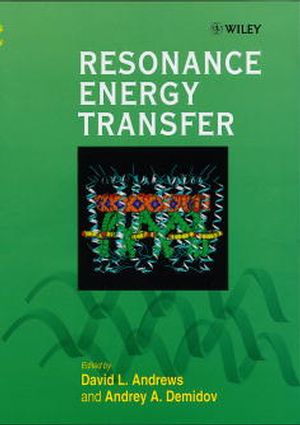Resonance Energy TransferISBN: 978-0-471-98732-1
Hardcover
488 pages
May 1999
 This is a Print-on-Demand title. It will be printed specifically to fill your order. Please allow an additional 15-20 days delivery time. The book is not returnable.
|
||||||
1. Resonance energy transfer in proteins; introduction; some basic considerations; a short history of FRET determinations; the components of the Foorster equation; quantum yield; determining spectral overlap; steady state or time-resolved measurements?; resonance energy transfer using intrinsic amino acids; homotransfer between intrinsic probes; heterotransfer; the range of distances determined by resonance energy transfer; precise location of resonance energy transfer probes; properties of probes; labeling specific residues in proteins; resonance energy transfer experiments using lanthanide ions; measurements in radially symmetrical systems; comparison with crystallographic distances; using resonance energy transfer to constrain molecular models; resonance energy transfer with single fluorophores: new wave experiments; intramolecular energy transfer in proteins bound to membranes; green fluorescent protein; resonance energy transfer and biosensors: a new and promising technique; shortcomings; the future of FRET; summary; dedication; acknowledgements; references.
2. Unified theory and radiative and raditionless energy transfer; introduction; background; the basis of the unified theory; spectral features; refraction and dissipation; dynamics of energy transfer between a pair of molecules in a dielectric medium; conclusion; appendix A: Heitler-MA method for analysis of the transition operator;
Appendix B: modified approach to the transition operator; references.
3. Dynamics of radiative transport; introduction; overview of atomic and molecular radiative transport; the Holstein-Biberman equation; multiple scattering representation; stochastic approach; combined radiative and nonradiative transport; conclusion; appendix A: probablitity of emission of a photon between t + dt for an nth generation molecule; appendix B: depolarization factor for radiative transferaccording to classical electrodynamics; references.
4. Orientational aspects in pair energy transfer; introduction;
Kappa-squared and probability, Kappa-squared and anisotropy; notes on the effects of order and motion; acknowledgements; references.
5. Polarization in molecular complexes with incoherent energy transfer; introduction; interaction of light with single molecules or chromophores; bichromophore molecular complexes; trichromophore complexes; multichromophore complexes with C3 symmetry; conclusion; appendix A; appendix B; appendix C; appendix D; references.
6. Theory of coupling in multichromophoric systems; introduction; reactant and product states: LMO model; the origin of coupling matrix elements; paradigmatic results; coulombic coupling; superexchange; interpretation of steady state spectra; calculation of couplings; acknowledgements; references.
7. Exciton annihilation in molecular aggregates; introduction; theory; applications; discussion; acknowledgements; references.
8. Energy transfer and localization: applications to photosynthetic systems; introduction; optical properties of dimers and aggregates; energy and localization in antenna complexes and reaction centers; acknowledgements; references.
9.Excitation energy transfer in photosynthesis; introduction; the structure of light-harvesting complexes; the mechanism of energy transfer and trapping in photosynthesis; dynamics of excitation energy transfer; conclusions; acknowledgements; references.
10. The Fenna-Matthews-Olson protein: a strongly coupled photosynthetic antenna; introduction; steady state spectroscopy;
FMO exciton simulations;
FMO primary processes; epilog and future prospects; acknowledgements; references.
11. Use of a Monte carlo method in the problem of energy migration in molecular complexes; introduction; an illustration of Monte Carlo calculations in the problem of fluorescence decay; energy transfer in CME: major algorithm; applications of monte Carlo simulations; conclusion; acknowledgements; references.
Index
2. Unified theory and radiative and raditionless energy transfer; introduction; background; the basis of the unified theory; spectral features; refraction and dissipation; dynamics of energy transfer between a pair of molecules in a dielectric medium; conclusion; appendix A: Heitler-MA method for analysis of the transition operator;
Appendix B: modified approach to the transition operator; references.
3. Dynamics of radiative transport; introduction; overview of atomic and molecular radiative transport; the Holstein-Biberman equation; multiple scattering representation; stochastic approach; combined radiative and nonradiative transport; conclusion; appendix A: probablitity of emission of a photon between t + dt for an nth generation molecule; appendix B: depolarization factor for radiative transferaccording to classical electrodynamics; references.
4. Orientational aspects in pair energy transfer; introduction;
Kappa-squared and probability, Kappa-squared and anisotropy; notes on the effects of order and motion; acknowledgements; references.
5. Polarization in molecular complexes with incoherent energy transfer; introduction; interaction of light with single molecules or chromophores; bichromophore molecular complexes; trichromophore complexes; multichromophore complexes with C3 symmetry; conclusion; appendix A; appendix B; appendix C; appendix D; references.
6. Theory of coupling in multichromophoric systems; introduction; reactant and product states: LMO model; the origin of coupling matrix elements; paradigmatic results; coulombic coupling; superexchange; interpretation of steady state spectra; calculation of couplings; acknowledgements; references.
7. Exciton annihilation in molecular aggregates; introduction; theory; applications; discussion; acknowledgements; references.
8. Energy transfer and localization: applications to photosynthetic systems; introduction; optical properties of dimers and aggregates; energy and localization in antenna complexes and reaction centers; acknowledgements; references.
9.Excitation energy transfer in photosynthesis; introduction; the structure of light-harvesting complexes; the mechanism of energy transfer and trapping in photosynthesis; dynamics of excitation energy transfer; conclusions; acknowledgements; references.
10. The Fenna-Matthews-Olson protein: a strongly coupled photosynthetic antenna; introduction; steady state spectroscopy;
FMO exciton simulations;
FMO primary processes; epilog and future prospects; acknowledgements; references.
11. Use of a Monte carlo method in the problem of energy migration in molecular complexes; introduction; an illustration of Monte Carlo calculations in the problem of fluorescence decay; energy transfer in CME: major algorithm; applications of monte Carlo simulations; conclusion; acknowledgements; references.
Index



